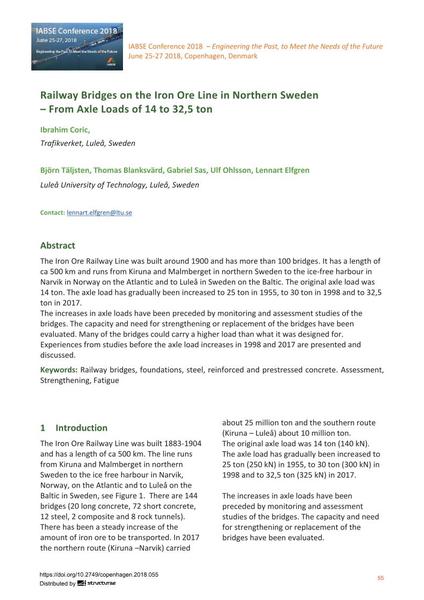Railway Bridges on the Iron Ore Line in Northern Sweden - from Axle Loads of 14 to 32,5 Ton

|
|
|||||||||||
Détails bibliographiques
| Auteur(s): |
Ibrahim Coric
(Trafikverket, Luleå, Sweden)
Björn Täljsten (Luleå University of Technology, Luleå, Sweden) Thomas Blanksvärd (Luleå University of Technology, Luleå, Sweden) Gabriel Sas (Luleå University of Technology, Luleå, Sweden) Ulf Ohlsson (Luleå University of Technology, Luleå, Sweden) Lennart Elfgren |
||||
|---|---|---|---|---|---|
| Médium: | papier de conférence | ||||
| Langue(s): | anglais | ||||
| Conférence: | IABSE Conference: Engineering the Past, to Meet the Needs of the Future, Copenhagen, Denmark, 25-27 June 2018 | ||||
| Publié dans: | IABSE Conference Copenhagen 2018 | ||||
|
|||||
| Page(s): | 55-61 | ||||
| Nombre total de pages (du PDF): | 7 | ||||
| DOI: | 10.2749/copenhagen.2018.055 | ||||
| Abstrait: |
The Iron Ore Railway Line was built around 1900 and has more than 100 bridges. It has a length of ca 500 km and runs from Kiruna and Malmberget in northern Sweden to the ice-free harbour in Narvik in Norway on the Atlantic and to Luleå in Sweden on the Baltic. The original axle load was 14 ton. The axle load has gradually been increased to 25 ton in 1955, to 30 ton in 1998 and to 32,5 ton in 2017. The increases in axle loads have been preceded by monitoring and assessment studies of the bridges. The capacity and need for strengthening or replacement of the bridges have been evaluated. Many of the bridges could carry a higher load than what it was designed for. Experiences from studies before the axle load increases in 1998 and 2017 are presented and discussed. |
||||
| Mots-clé: |
acier ponts ferroviaires renforcement
|
||||
